
Theni Eswar : Veera Dheera Sooran Part – 2!
Mar 28 2025
Cinematographer Theni Eswar on Crafting Darkness in Veera Dheera Sooran Part – 2


Theni Eswar ISC
Theni Eswar, is one of the cinematographers, is known for deeply immersive and naturalistic approach to visual storytelling. His ability to craft light and shadow with precision has made him a sought-after name in Tamil cinema. Whether it’s the raw, sunlit landscapes of Merku Thodarchi Malai or the rich, atmospheric frames of Karnan, Eswar’s work is characterized by a deep understanding of mood, texture, and realism. In his latest venture, Veera Dheera Sooran Part – 2, Eswar takes on the challenge of shooting a film almost entirely set at night, creating a visual experience that is both haunting and dynamic.
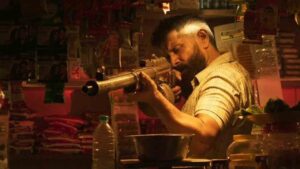
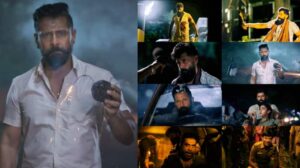
Veera Dheera Sooran Part – 2 is almost entirely set at night. How did you approach the challenge of shooting a night-based film?
The biggest challenge was making sure the audience didn’t feel like they were watching a film that was visually monotonous. I worked on creating different night atmospheres throughout the movie, playing with variations in lighting, depth, and texture to keep the visuals engaging.
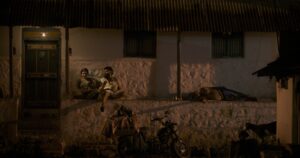

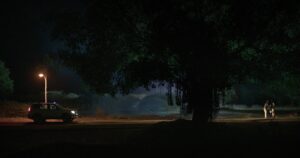
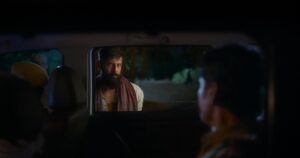
You mentioned creating depth with darkness. How did you achieve that?
Creating depth was crucial. I used distance within the frame to enhance the sense of vastness. I would place a small light source deep in the background to extend into an infinite space, giving a natural expansion to the scene.
What lens choice did you go with for this film?
I primarily shot with a 50mm lens on a handheld setup. I wanted to maintain a natural perspective that felt immersive, giving the audience a more organic visual experience.
Since almost the entire film was shot at night, how did you plan your lighting setup?
To maintain energy on set and avoid delays, we would start setting up the lighting from 2 PM in the afternoon. This allowed us to be fully ready by the time we started shooting at night. It also helped the actors stay focused without interruptions.

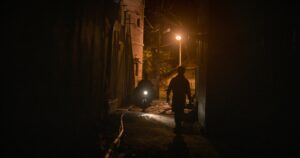
The film was shot in remote locations. How did you handle lighting in such areas?
Since we didn’t have existing street lights, we created our own. We installed nearly 40 to 50 practical street lamps designed to mimic sodium vapor lights, ensuring the environment looked realistic while giving us complete control over the lighting.
What were your key lighting techniques for the film?
Most of the time, I relied on cross key lighting from a higher plane. This helped illuminate the scenes while maintaining a natural feel.
What camera and lenses did you use for the project?
We used the Alexa Mini LF paired with Signature Prime lenses.
The film has a major festival sequence. How did you bring that visual energy to life?
To capture the essence of a festival, we incorporated bursting crackers across the sky, breaking the darkness and adding scale to the frame.
In scenes where fireworks weren’t directly shown, how did you maintain the festival mood?
We used powerful LED RGB lights placed 40 feet high on a rig. These multi-colored lights reflected on cars, streets, and faces, subtly mimicking the light of fireworks. We operated them through computing for precise control, ensuring they complemented the sound design.
The story unfolds in a single night and builds towards a sunrise. How did that influence your cinematography?
The film has a sense of urgency—there’s a gang on the run, a police officer chasing them, and a weapon of mass destruction in play. Every visual decision was made to enhance that tension while making the darkness feel like a living, breathing element in the story.
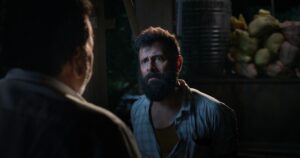
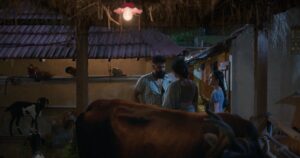
What was it like working with Vikram on this project?
All the artistes were very camera-friendly due to their experience. Vikram sir, in particular, was very involved in the process. He would often ask about the key light sources I maintained during long takes, using an on/off method to keep consistency in lighting.

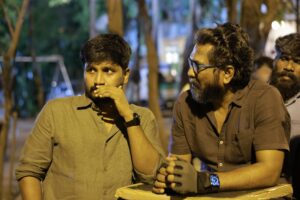

Looking back, how would you describe your experience working on Veera Dheera Sooran Part – 2?
It was a deeply rewarding project. The brilliant writing by director SU Arun Kumar balanced emotions, action, and thrills perfectly. It was a challenge, but one that allowed me to push my creativity in night cinematography to new levels.
Article by
CJ Rajkumar
Author/ Cinematographer
